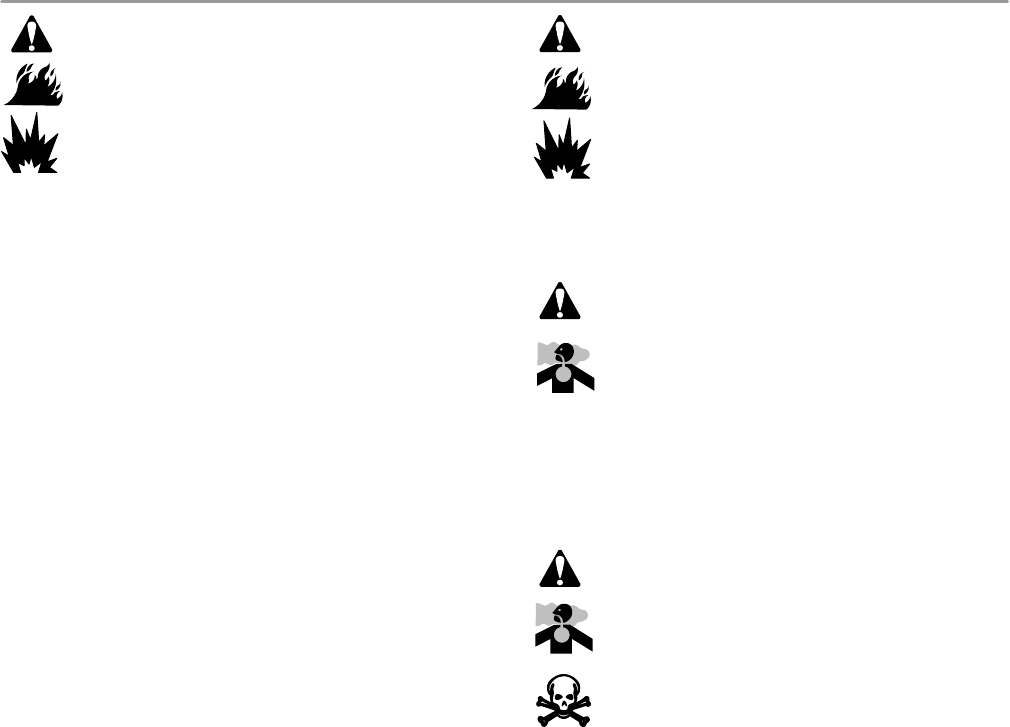Operator`s manual

Operator Safety
4 BRIGGSandSTRATTON.COM
When Adding Fuel
• Turn engine off and let engine cool at least 2
minutes before removing the fuel cap.
• Fill fuel tank outdoors or in well-ventilated
area.
• Do not overfill fuel tank. Fill tank to
approximately 1.5 inches (38 mm) below top
of neck to allow for fuel expansion.
• Keep gasoline away from sparks, open
flames, pilot lights, heat, and other ignition
sources.
• Check fuel lines, tank, cap, and fittings
frequently for cracks or leaks. Replace if
necessary.
• If fuel spills, wait until it evaporates before
starting engine.
When Starting Engine
• Ensure that spark plug, muffler, fuel cap and
air cleaner are in place and secured.
• Do not crank engine with spark plug removed.
• If engine floods, set choke (if equipped) to
OPEN/RUN position, move throttle (if
equipped) to FAST position and crank until
engine starts.
When Operating Equipment
• Do not tip engine or equipment at angle which
causes gasoline to spill.
• Do not choke the carburetor to stop engine.
• Never start or run the engine with the air
cleaner assembly or the air filter removed.
When Changing Oil
• If you drain the oil from the top oil fill tube, the
fuel tank must be empty or fuel can leak out
and result in a fire or explosion.
When Transporting Equipment
• Transport with fuel tank EMPTY or with fuel
shut-off valve OFF.
When Storing Gasoline Or Equipment With
Fuel In Tank
• Store away from furnaces, stoves, water
heaters or other appliances that have pilot
light or other ignition source because they can
ignite gasoline vapors.
WARNING
Gasoline and its vapors are extremely
flammable and explosive.
Fire or explosion can cause severe burns or
death.
Starting engine creates sparking.
Sparking can ignite nearby flammable gases.
Explosion and fire could result.
WARNING
• If there is natural or LP gas leakage in area,
do not start engine.
• Do not use pressurized starting fluids
because vapors are flammable.
Engines give off carbon monoxide, an
odorless, colorless, poison gas.
Breathing carbon monoxide can cause
nausea, fainting or death.
WARNING
• Start and run engine outdoors.
• Do not start or run engine in enclosed area,
even if doors or windows are open.
Contents are HARMFUL OR FATAL IF
SWALLOWED. Avoid contact to eyes, skin, or
clothing. Do not take internally. Avoid
breathing the mist or vapor. Overexposure to
eyes or skin can cause irritation. KEEP
STABILIZER OUT OF THE REACH OF
CHILDREN.
Fuel stabilizer is a hazardous chemical. **
WARNING
• IF SWALLOWED, call physician immediately.
Do not induce vomiting. If inhaled, remove to
fresh air. In case of eye or skin contact, flush
with water for 15 minutes.
• Store unopened cartridges in a cool, dry,
well-ventilated area. Keep open cartridge in
fuel cap and fuel cap closed on fuel tank when
not in use.
** Fuel stabilizer contains: 2,6-di-tert-butylphenol
(128-39-2) and aliphatic petroleum distillate
(64742-47-8).
• In case of emergency, contact a physician
immediately and call 1-800-424-9300 for
material safety information.










